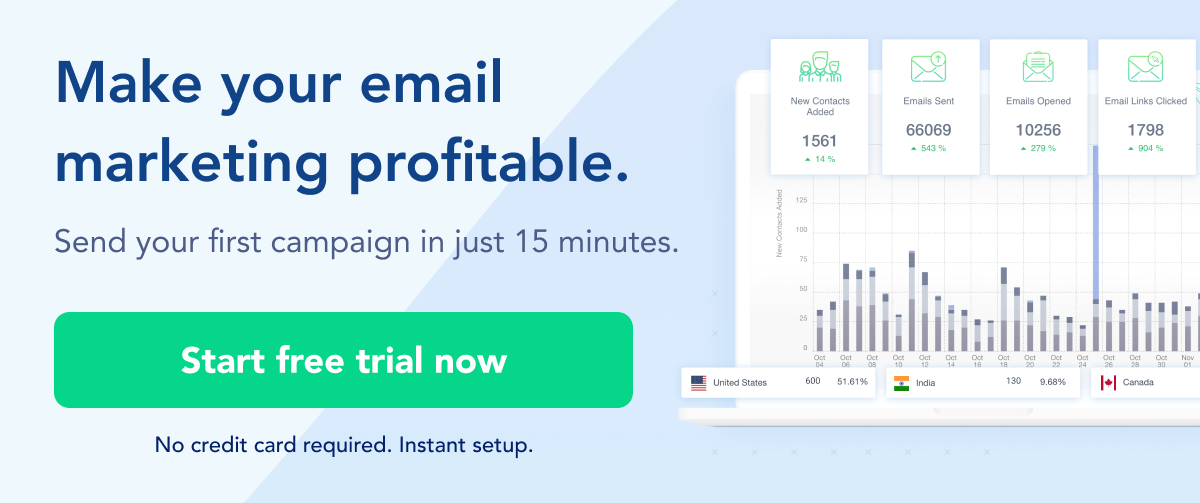In 2022, the number of email users worldwide was forecasted to be 4.3 billion. This figure is set to grow to 4.6 billion in 2025. The daily number of emails sent and received totaled 293.6 billion. Despite the huge competition in email marketing, newsletters still remain an effective channel for sales and communication with the audience.
Of course, today, it is worth a lot of effort to attract the user's attention, motivate them to subscribe, and then not get lost in the inbox among dozens of other emails. Email etiquette contributes to this. Good email etiquette leads to higher open and click-through rates, increased conversion rates, enhanced brand loyalty, and reduced unsubscribes and complaints. It fosters trust, engagement, and a positive brand reputation.
In this article, you will learn 5 tips to maintain great email etiquette and impress your subscribers.
Table of Contents
Tip 1: Personalize Your Emails
You won't achieve your email marketing goals if you send irrelevant content to your subscribers. Segmented email campaigns are more clickable than unsegmented ones, and personalization increases revenue.
To personalize content, first segment your audience. There are different ways to group subscribers into segments:
- By gender and age
- By geolocation
- By category of products purchased
- By purchase amount
- By website or email behavior
- By interests
- By place of work
- By subscription duration.
You can do the initial segmentation at the subscription stage.
Further, create personalized content for each group of subscribers to increase the relevance of newsletters and sales. Utilize all the information available about customers and even newsbreaks. Congratulations on professional holidays and birthdays. And if the user didn't share this information, create a newsbreak yourself. For example, congratulate a person on the anniversary of his or her subscription and give a discount.
Don't forget to personalize the subject line. Based on it, 64% of recipients decide to open or delete emails. Add emoji. Emotional content increases effectiveness. And to stand out among other emails, you can use Unicode. The YayText website will help you with this. However, to avoid errors, be sure to check before sending how the subject line is displayed in different mailboxes.
Tip 2: Craft Compelling Subject Lines
Subject lines are crucial in grabbing attention and enticing recipients to open emails. They serve as the first impression of an email and can significantly impact open rates.
5 tips for creating engaging and click-worthy subject lines:
- Keep it concise. Aim for subject lines that are clear and concise, typically between 6 to 10 words. Shorter subject lines are easier to read and more likely to grab attention.
- Use compelling language. Choose words and phrases that evoke emotion, curiosity, or excitement. Avoid generic or spammy language that may deter recipients from opening the email.
- Test different variations. A/B testing subject lines can help determine which ones resonate best with your audience. Experiment with different lengths, tones, and messaging to optimize open rates.
- Highlight the value proposition. Clearly communicate the benefit or value of opening the email. Whether it's a special offer, exclusive content, or useful information, clarify why recipients should engage with the email.
- Avoid spam triggers. Steer clear of spammy tactics like excessive punctuation, all caps, or overly promotional language. These can trigger spam filters and decrease deliverability.
Also, we recommend you track those who have stopped opening newsletters and reactivate them. Motivate passive subscribers to interact again and increase customer retention. For example, offer them a personalized discount or other benefit to encourage them to perform the desired action.
If the user did not open the reactivation newsletter, send it again, but change the subject line. If even this does not bring results, delete the email address. Remember, it's not the size of the mailing list that matters, but its quality. Remove uninterested subscribers to avoid distorted statistics and accumulation of invalid addresses.
Tip 3: Mind Your Timing
Time affects the effectiveness of email campaigns. Dozens of emails are accumulated in the user's inbox every day. To avoid getting lost among them, it is necessary to know when it is better to send an email. However, there is no exact time because it depends on the target audience, business sphere, and other factors.
How to determine the best day and time? Here are two tips that will help you figure it out:
- Analyze your website statistics. See which days of the week and at what time the traffic is highest. Then, make a mailing according to the data and analyze the result.
- Look at competitors' mailings. This is not the most accurate way, but it can be useful. More often than not, users subscribe to offers from different companies, so in addition to your emails, they also receive your competitors' emails. See when they do mailings and try to send your campaigns a little earlier or, on the contrary, later. Do A/B testing to confirm or deny the guesses and find the optimal time.
Don't forget to track statistics and analyze performance.
Tip 4: Provide Value in Every Email
The longer a user subscribes to a company, the weaker his or her engagement is. Therefore, you should regularly fight for attention and create different creative campaigns to keep recipients interested in newsletters. Add useful videos, interactive elements, and GIFs to your emails.
Many companies often add GIFs to their emails to showcase products and make the email more interesting. Try to come up with your own gif. You can use two approaches in your email newsletters: a humorous one and a more serious one. This helps to maintain engagement.
To not miscalculate with creatives, don't rely only on your intuition. Conduct split testing. Create two versions of your newsletter and test the subject line, call to action button or content. Split testing helps you determine the most effective email format.
This co-marketing partnership email exceeded expectations. Surprisingly, the discount code also served as a bonus promotion for Rent the Runway, a dress rental company that aligns well with the interests of Birchbox customers. It definitely caught her eye and brought a pleasant surprise.
Tip 5: Ensure Clear Call-to-Actions (CTAs)
CTAs are critical in guiding subscribers to take desired actions within emails. They serve as the gateway between the email content and the intended action, whether it's making a purchase, signing up for a newsletter, or downloading a resource.
Tips for creating clear, compelling, and actionable CTAs in your emails:
- Be clear and concise. Use straightforward language that clearly communicates the desired action. Avoid ambiguity or confusion by keeping CTAs concise and to the point.
- Use Compelling verbs. Use action-oriented verbs that encourage immediate engagement, such as "Shop Now," "Download," "Subscribe," or "Learn More." These verbs instill a sense of urgency and compel recipients to act.
- Highlight benefits. Clearly articulate the value or benefit of clicking the CTA. Explain what recipients stand to gain by taking the desired action, whether it's access to exclusive content, savings on a purchase, or solving a problem.
- Create visual contrast. Make CTAs visually stand out within the email by using contrasting colors, bold fonts, or button formatting. Ensure that CTAs are easily identifiable and clickable across different devices and email clients.
- Optimize placement. Place CTAs strategically within the email, ideally above the fold and prominently displayed. Experiment with placement to determine the most effective positioning for driving clicks and conversions.
- Provide direction. Offer additional context or guidance if necessary to encourage action. For example, explain briefly what recipients can expect after clicking the CTA or any requirements for accessing an offer.
- Test and iterate. A/B tests different variations of CTAs to identify which ones resonate best with your audience. Experiment with different wording, colors, sizes, and placements to optimize performance over time.
By following these tips, you can create CTAs that effectively guide subscribers toward desired actions, driving engagement and conversions within email campaigns.
Conclusion
Today, it's hard to stand out among your competitors, but it's critical to achieving your goals. Subscribe to other companies' newsletters. Analyze their mail design, content, and personalization methods. Think about what you should take note of and what you can do better. Don't repeat your competitors' techniques, be original.
Remember, for successful email marketing you need more than just getting a user's contact - you need to win their favor and keep their attention. Email etiquette helps with this. Therefore, monitor statistics, test email newsletters, analyze the results, and regularly improve your campaigns.



